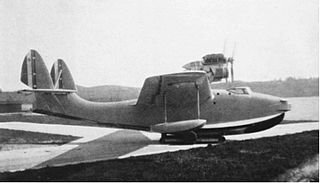| CA.124 | |
|---|---|
 | |
| Role | Reconnaissance and bomber seaplane |
| National origin | Italy |
| Manufacturer | Societa Italiana Caproni |
| First flight | c.1937 |
| Number built | 1? |
The Caproni Ca.124 was a 1930s single-engine Italian reconnaissance and bomber seaplane.
| CA.124 | |
|---|---|
 | |
| Role | Reconnaissance and bomber seaplane |
| National origin | Italy |
| Manufacturer | Societa Italiana Caproni |
| First flight | c.1937 |
| Number built | 1? |
The Caproni Ca.124 was a 1930s single-engine Italian reconnaissance and bomber seaplane.
The Caproni Ca.124 was a cantilever mid-wing monoplane of mixed construction. The fuselage was corrugated-skinned and the empennage cantilever and conventional, with the tailplane set at mid-fuselage. The pilot's cockpit was forward of the leading edge. It was a floatplane, mounted on metal floats each attached to the wings by pairs of N-form laterally orientated struts. [1]
The Ca.124 was powered by a 900 hp (670 kW) Isotta Fraschini Asso XI.RC15, a water-cooled upright V-12 engine, supercharged to maintain power to 1,500 m (4,920 ft). Bombs were contained within the fuselage, below the wing. [1]
Data fromJane's All the World's Aircraft 1938 [1]
General characteristics
Performance

The Caproni Ca.135 was an Italian medium bomber designed in Bergamo in Italy by Cesare Pallavicino. It flew for the first time in 1935, and entered service with the Peruvian Air Force in 1937, and with the Regia Aeronautica in January 1938.

The Caproni Ca.165 was an Italian biplane fighter developed just before World War II, but produced only as a prototype, as the competing Fiat CR.42 Falco was selected for series production.
The Piaggio P.32 was an Italian medium bomber of the late 1930s, produced by Piaggio, and designed by Giovanni Pegna. It was a modern design for its time, but was a failure due to lack of powerplants commensurate with its high wing loading.

The Caproni Ca.73 was an Italian airliner produced during the 1920s which went on to serve as a light bomber in the newly independent Regia Aeronautica.

The Caproni Ca.355 Tuffo was a low-wing single-engine dive bomber, designed and built by the Italian Caproni company in 1941, which never proceeded beyond a single prototype. Derived from Ca.335 Mistral, the Ca.355 was proposed to equip the Regia Aeronautica, but it was found to offer little advantage over the German Junkers Ju 87 "Stuka" and the project was abandoned.

The Caproni Vizzola F.4 was an Italian fighter aircraft prototype that was designed in 1937 and built from 1939. It was a single-seat, low-wing cantilever monoplane with retractable landing gear.

The Piaggio P.23R, also known as the Piaggio P.123 for propaganda purposes, was an Italian commercial transport aircraft prototype designed and built by Piaggio.

The Caproni Ca.90 was a prototype Italian heavy bomber designed and built by Caproni. When it first flew in 1929 it was the largest land-based aircraft in the world.

The twin-engined CANT Z.1011 was one of two bombers of about the same size and powered by the same engines, designed by Filippo Zappata in the mid-1930s. The other was the three-engined CANT Z.1007, which in the end was the type preferred by the Regia Aeronautica.

The Asso XI was a family of water-cooled, supercharged V12 piston aeroengines produced in the 1930s by Italian manufacturer Isotta Fraschini, and fitted on a number of aircraft types built by CANT, Caproni and others.

The Reggiane Re.2004 was an Italian single-engined monoplane made by Reggiane and designed by Roberto Longhi. The aircraft never passed the preliminary stages.

The Macchi M.C.99 was a prototype 1930s Italian twin-engined torpedo-bomber flying boat designed and built by Macchi.

The Caproni Ca.95 was a large, three engine, long range, heavy bomber prototype built in Italy in 1929. It could carry a 1,600 kg (3,500 lb) bomb load and had three defensive gun positions. Only one was built.
The Caproni Ca.61 was an Italian heavy day bomber aircraft of 1922. It was the final development of the Caproni three engine, twin boom biplane types developed during World War I, but it was not put into production.
The Caproni Ca.134 was a biplane reconnaissance aircraft built by the Italian company Caproni in the 1930s.
The Caproni Ca.91 was a proposed Italian flying boat designed by Caproni.
The Caproni Ca.79 was an Italian light bomber produced in the mid-1920s.
The Caproni Ca.120 was a three-engine monoplane bomber built by Caproni in the 1930s.
The Caproni Ca.127 was a single-engine reconnaissance monoplane built by Caproni in the mid-1930s.
The Caproni Ca.146 was a high-wing reconnaissance aircraft built by Caproni in the mid-1930s.